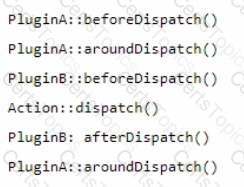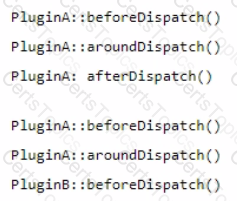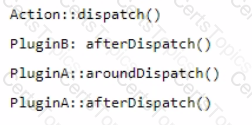An Adobe Commerce developer was asked to provide additional information on a quote. When getting several quotes, the extension attributes are returned, however, when getting a single quote it fails to be returned.
What is one reason the extension attributes are missing?
The developer is required to convert a modules database scripts from old install/upgrade setup files to a data patches format and does not want to apply database changes that were already done by install/upgrade scripts.
The current module version is 1.5.4.
What would be the recommended solution to skip changes that were already applied via old format (install/upgrade scripts)?
A Project Architect needs to add a new developer who needs to be able to push code in an Adobe Commerce Cloud project. No integration with a third-party repository provider is setup.
What two actions would be required to ensure the developer has access? (Choose Two.)
An Adobe Commerce Developer wishes to add an action to a pre-existing route, but does not wish to interfere with the functionality of the actions from the original route.
What must the developer do to ensure that their action works without any side effects in the original module?
An Adobe Commerce developer adds a new extension attribute to add an array of values to the invoices that are fetched through the APIs.
After a while, their technical manager reviews their work and notices something wrong with the extension_attributes. xml file that the developer created in their module:
What is the problem with this xml snippet?
There is the task to create a custom product attribute that controls the display of a message below the product title on the cart page, in order to identify products that might be delivered late.
The new EAV attribute is_delayed has been created as a boolean and is working correctly in the admin panel and product page.
What would be the next implementation to allow the is_delayed EAV attribute to be used in the .phtml cart page such as $block->getProduct()->getIsDelayed()?
A)
Create a new file etc/catalog_attributes.xmi:

B)
Create a new file etc/extension attributes.xmi:

C)
Create a new file etc/eav attributes.xmi:

An Adobe Commerce Cloud project is using Enhanced Integration Environments with two install a new payment module.
The developer is using Cloud CLI for Commerce tool.
What would a developer do to test this new feature under the integration environment?
An Adobe Commerce developer has created a process that exports a given order to some external accounting system. Launching this process using the Magento CLI with the command php bin/magento my_module:order: process --order_id=
Example: php bin/magento my_module:order:process --order_id=1245.
What is the correct way to configure the command?
A)

B)

C)

D)

An Adobe Commerce developer is asked to change the tracking level on a custom module for free downloading of pdf and images.
The module contains following models:
Vendor\FreeDownload\Model\Download
Vendor\FreeDownload\Model\DownloadPdf extends Vendor\FreeDownload\Model\Download
Vendor\FreeDownload\Model\DownloadImage extends Vendor\FreeDownload\Model\Download
Download class has a parameter for tracking_level.
How will the developer configure the tracking_level parameter, in di.xml.to have a value of 4 for Download class and all classes that extend Download?
A)

B)

C)

When researching some issues with the indexer, an Adobe Commerce developer is seeing errors in the logs similar to Memory size allocated for the temporary table is more than 20% of innodb_buffer_pool_size. It is suggested that the client update innodb_buf f er_pool_size or decrease the batch size value.
Why does decreasing the batch size value improve performance?
On an Adobe Commerce Cloud platform, in which order does the ECE-Tools package apply patches?
An Adobe Commerce developer wants to generate a list of products using ProductRepositorylnterf ace and search for products using a supplier_id filter for data that is stored in a standalone table (i.e., not in an EAV attribute).
Keeping maintainability in mind, how can the developer add the supplier ID to the search?
The di. xml file of a module attaches two plugins for the class Action.
The PluginA has the methods: beforeDispatch, aroundDispatch, afterDispatch. The PluginB has the methods: beforeDispatch, afterDispatch.

The around plugin code is:

What would be the plugin execution order?
A)

B)

C)

A message queue currently has queue/consumer-wait-for-messages set to true, which allows the consumer process to run until a message is inserted into the queue. A piece of functionality is driven by data stored in the model
\Magento\variable\Model\variable and this value is only loaded once during the consumer run. If the variable is updated we want the consumer to restart so that the new value is loaded into memory without having to reload the variable on each message consumed.
The Adobe Commerce developer has created an after plugin on the \Magento\Variable\Model\variable:: save() function.
How would the developer use the plugin to trigger the consumer restart?
An Adobe Commerce developer is creating a new console command to perform a complex task with a lot of potential terminal output. If an error occurs, they want to provide a message that has higher visibility than some of the other content that may be appearing, so they want to ensure it is highlighted in red (as seen in the screenshot):

How can they customize the appearance of this message?
When checking the cron logs, an Adobe Commerce developer sees that the following job occurs daily: main.INFO: Cron Dob inventory_cleanup_reservations is successfully finished. However, the inventory_reservation table in the database is not emptied. Why are there records remaining in the inventory_reservation table?
An Adobe Commerce developer is creating a module (Vendor.ModuleName) to be sold on the Marketplace. The new module creates a database table using declarative schema and now the developer needs to make sure the table is removed when the module is disabled.
What must the developer do to accomplish this?
An Adobe Commerce developer has installed a module from a third-party vendor. This module fires a custom event named third_party_event_after and also defines an observer named third_party_event_after_observer that listens to that event. The developer wants to listen to this custom event in their own module but wants to execute their observer's logic after the third_party_event_after_observer observer has finished executing.
What would the developer do to ensure their observer runs after the observer defined by the third-party module?
For security reasons, merchant requested to a developer to change default admin url to a unique url for every branch/environment of their Adobe Commerce Cloud project.
Which CLI command would the developer use update the admin url?
An Adobe Commerce developer is tasked to add a file field to a custom form in the administration panel, the field must accept only .PDF files with size less or equal than 2 MB. So far the developer has added the following code within the form component xml file, inside the fieldset node:

How would the developer implement the validations?
A)
Add the Validations Within the HyVendor\MyModule\Controller\Adminhtml\CustomEntity\UploadPdf Controller

B)
Add a virtual type forMyvendor\MyModuie\Modei\customPdfupioader specifying the aiiowedExtensions and the maxFiiesize for the constructor, within the module's di.xmi:

C)
Add the following code inside the
